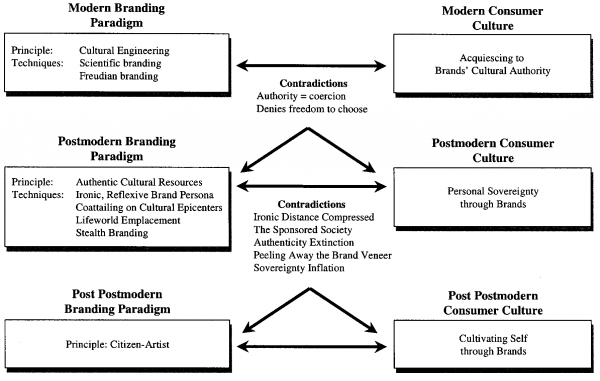So apparently it’s “The Future of Advertising” time. Again.
There’s a a Fast Company article with that title compiling interviews with a host of well-respected industry people circulating, that was as usual followed by a storm of retweets and opinions. While the arguments are all valid and interesting and while I certainly have an opinion about the topic myself, I immediately had to think of something I wrote in 2008 (in German) when I was analyzing the then darling of the advertising industry – ‘viral’ advertising – for my bachelor thesis. So because I still think it’s true, I thought it might be a good idea to translate the piece. Here is the trimmed down version:
One thing that concepts like ‘guerilla marketing’, ‘viral’ marketing or ‘viral’ advertising all have in common is a more or less implicit assumption of a crisis of advertising: ‘annoyance by advertising’, ‘flood of advertising’ and ‘avoidance of advertising’ are the commonly used concepts in the discourse.
Say ‘design’ and people think Rams, Ives, Eames. Say advertising and they think Cillit Bang.
… Russell Davies wrote in his blog in 2008. And he’s certainly not wrong. However, people’s attitude towards advertising is a bit paradox. While advertising (in general) provokes exactly the above mentioned reactions, advertising (in particular cases) is often remembered with joy, as Zurstiege (2005: 26ff) shows in his research. While zapping and DVRs lead to growing pains for advertisers, there are hundreds of ads on YouTube with thousands or even millions of views. [At the point when I wrote this, there was no Old Spice or Write The Future to refer to but only a Gorilla playing the drums.] All this approaches like ‘viral’ advertising, ‘viral’ marketing, guerilla marketing and whatnot tried to fulfill their effect by packing themselves as an “entertainment present” (Zurstiege 2007: 143) and to therefore counteract advertising avoidance and advertising annoyance.
I believe if you want to be successful in the world of viral, you need to play by the rules of entertainment, not the rules of selling.
(Kevin Roddy 2006)
Entertainment, however, isn’t exactly a new approach. All along, at least in theory advertising tried to bring outstanding things to the consumers’ eyes. This is – after all, what led to the aestheticisation of advertising through the employment of renowned artists in the 19th century in the first place (Zurstiege 2007: 22f).
Leaving advertising annoyance and advertising avoidance aside for a second, there’s of course also a lack of trust in the effects of advertising. As a representative for this part of the discourse who’s better to quote than Philip Kotler:
The average American is exposed to several hundred ad messages a day and is trying to tune out. TV advertising is losing its effectiveness because of growing advertising clutter, the increasing number of channels, the availability of zapping mechanisms, and reduced watching of television by certain groups. The result is that marketers must consider other methods of getting consumer attentions.
(Kotler 2005)
This chain of reasoning – information overload, explosion of channels, media use – is found in pretty much every introducing statement of pretty much every alternative approach:
Because of an increasing amount of media and advertising, DVRs and the changed media use, even more since the rise of the internet, we need new methods to solve the crisis of advertising.
That’s how it goes. And be it online-advertising, PR, event marketing or the much quoted ‘integrated communication’, all of them are united by the fact that they lay claim to the leadership role in clients’ marketing budget. [And the same may be said about ‘transmedia’ and ‘crowdsourceing’ and whatever other approach …]. But while information overload might partly explain the development of new approaches that aim at media content spreading digitally, even this isn’t a new phenomenon. What we have institutionalized as ‘information overload’ and ‘advertising clutter’ already had a name in the 19th century: Schilderpest (‘signboard plague’) (Zurstiege 2008: 129).
Advertising was finished from the outset. [“Die Werbung war von Anfang an am Ende.”]
(Schmidt 2004: 53ff)
The accusation of lying, the persistant suspicion of manipulation, the ‘sensory overload’ and the identity crisis because of the supposed incapability to produce socially and culturally relevant outcomes (cf. Schmidt 2004: 54), are all derived from the social functional system advertising itself. [It’s in it’s DNA, if you want to say it like that.]
Advertising produces scarcity of attention by achieving attention. Advertising needs bad advertising to stand out with good. Advertising – as a system – necessarily produces its own problems and solves it by adapting to changing social conditions (ibid. 73f). Advertising – and this is also shown by the appearance of ‘viral advertising’ [insert buzzword here] – lives on new problems which can then be opposed by the creation of new and differentiating approaches (ibid. 74). The crisis of advertising [and therefore the question about it’s future] isn’t new, but an essential part of the system, the permanently repeats itself under different circumstances.
Sources:
- Davies, Russel (2008): on the goodness and badness of advertising
- Kotler, Philip: Advertising vs. PR: Kotler on Kotler.
- Kotler, Philip/Bliemel, Friedhelm (2006): Marketing-Management. Analyse, Planung und Verwirklichung. 10., überarbeitete und aktualisierte Auflage. München [u.a.]: Pearson Studium.
- Roddy, Kevin (2006) in Leonard, Devin (2006): Viral Ads: It’s an Epidemic. In: Fortune. New York: 2. Oktober 2006, 154. Jg., Heft 7/2006, 61.
- Schmidt, Siegfried J. (2004): Die Werbung ist vom Anfang an am Ende. In: Die Depression der Werbung : Berichte von der Couch / Berliner KommunikationsFORUM e.V. Sebastian Kemmler … (Hrsg.).Göttingen: Business Village, 53-77.
- Zurstiege, Guido (2005): Zwischen Kritik und Faszination. Was wir beobachten, wenn wir die Werbung beobachten, wie sie die Gesellschaft beobachtet. Köln: Halem.
- Zurstiege, Guido (2007): Werbeforschung. Konstanz: UVK-Verl.-Ges.
- Zurstiege, Guido (2008): Der Konsum Dritter Orte. In: Kai-Uwe Hellmann (2008): Räume des Konsums: Über den Funktionswandel von Räumlichkeit im Zeitalter des Konsumismus. Wiesbaden: VS, Verl. für Sozialwissenschaften.

